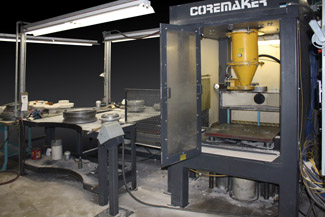Foundry & industrial processing Machinery EQUIPMENT & SYSTEMS
U.S. & Canada Call 1.800.457.5456
RFID for foundry mould and coremaking
Home Articles RFID for foundry mould and coremaking

Jack Palmer, President of Palmer Manufacturing and Supply Inc discusses the benefits of using radio frequency identification tags in foundry production.
October/November 2010
Reprinted with permission from Cast Metal and DieCasting Times

Adjusting settings, recalling recipes, and documentation of recipe changes all require costly human intervention. And, when not performed correctly, result in costly human errors. RFID (radio frequency identification tags) represent a major break-through in foundry production, to reduce time for recipe management, the prevention of costly errors and enhance quality control. Unlike other key manufacturing breakthroughs, RFID can be deployed on specific equipment for a particular process or can be deployed plant-wide. Users have the ability to expand automation a little at a time, making this ideal for both small and large foundries.
How RFID works
RFID is an automatic identification system that relies on storing and retrieving data using radio-frequency identification tags. Unlike other methods of identification, RFID has the major advantage of being completely programmable (read/write).
RFID identification uses 'tags' – small electronic devices that are fastened to the mould or core box and 'readers' which are devices that communicate wirelessly with the RFID tags and to the data for that tag. Data includes mixer run time, resin percentage, resin ratio, catalyst percentage, dry additive percentage, compaction table vibration intensity and duration, and can be incorporated seamlessly into a company-wide Ethernet.
Both the tag and the radio are two-way radios. The reader interfaces with the PLC to transfer the data obtained from the tag to allow the PLC to set the mixer and conveyor/carousel parameters. Recipe numbers and settings are entered into the tag via a touch-screen on the mixer control panel or another PLC. This means programming can take place at the production line if needed. While a tag can be reprogrammed at any time, password protection can easily be added to ensure recipes are not altered.
RFID in the core room

Perhaps one of the easiest places to introduce a foundry to RFID is in the core room. Excal Inc one of North America’s premier brass and bronze foundries, producing over 2,000 different patterns for cores of different sizes and shapes. The company found this the ideal place to implement the new RFID CM-CoreMaker™ from Palmer Manufacturing & Supply Inc.
The process is not difficult, as a tag is simply fastened to the bottom of each core box. The tags (compliant with ISO 18000-3, ISO 15693, and ISO 14443 standards) each have a unique identification number that is read when the box is presented to the CoreMaker. During the set-up procedure, the worker enters the settings for that particular core box into the machine’s programmable logic controller (PLC). Once the setting is determined, the worker saves it permanently to that recipe.
"This equipment allows us to compete with lower prices from offshore foundries because we can truly guarantee quality" comments Mike Baures, Excal's Plant Manager. "But that’s not all – our productivity has increased 65% versus our prior system." The machine's improved efficiency, ease of operation, and improved ergonomics allows the foundry to pay a higher skilled person, higher wages, as opposed to seeking more persons for employment. The higher skill level lends itself to improved safety, training, cross training and advancement for that individual. "The quality control is built into the machine with the RFID tags and therefore, reduces the number workers needed," he adds.
To begin coremaking, the RFID interrogator built into the coremaker bench, reads the tag’s number, and transmits that information to the PLC. Then, the computer retrieves the settings for that core. The worker presses one more button to begin the coremaking process, and the core box is moved into the core blower. The computer instructs the blower accordingly and injects sand and chemicals before purging the box. “An interesting part of this machine’s operation is that the employee is stripping a corebox while the machine is blowing and curing another. The operator has no real downtime waiting on the machine" confirms Mike Baures.
Mr. Baures also adds that the previous system had major ergonomic issues that this coremaker completely solved. Lifting of heavy core boxes has been greatly reduced due to the conveyor and the reader. "On labour savings alone, the payback on this unit was 15 months." It was much faster than that, when you factor in the increased production. We felt fortunate that Palmer had the engineering talent to customize this unit for us. I have never been more excited about adding this technology to our plant – I knew it would work" he confirms.
While many are quickly attracted to the labour savings aspect of RFID, the ability to make higher quality cores is an even bigger incentive. Anytime you allow a worker to manually change recipes, your core’s condition can be expected to change. Excessive amine catalyst material can weaken a core after metal is poured. RFID ensures that the core is guaranteed to be made with the proper settings. Higher quality cores mean higher quality parts.
Expand RFID to both no-bake moulding and coremaking and watch it deliver greater labour savings, enhanced quality control and the additional advantage of getting accurate data which, in turn, helps to better manage production and raw materials inventory.
After programming, just like with the core box, the RFID tag is attached to the mould box to identify itself to the mixer. As the box flows past the RFID reader, the system reads the information on the tag and sends the information to the operating system. The read function can be automatic or the operator can perform it with a hand held reader. Depending on the tag, it can hold different amounts of data.
Having started the cycle, the operator is no longer needed for decision making (mixer run time, resin levels, powder additives etc). The operator only needs to move the sand to the correct part of the box as it is discharged to be sure the pattern is covered with the correct recipe. Mixers that are equipped with an automated fill pattern mechanism with an auto strike-off function, such as the Palmer SmartFill™ (after the fill station) will not need an operator for this function.
Programming generally consists of:
- Mixer run time
- Resin level to start and back-up (and when to change)
- Powder additional level – when to start and stop
- When to begin compaction table cycle, with force output & vibration duration specifications.
- Automated Fill Pattern
The amount of sand and binder being used is data easily captured and stored by the system. This allows management to maintain optimum inventory control of these consumables. The system can also be used for better production management as it has the ability to track moulds or cores per shift etc.
When RFID technology is deployed plant-wide, the benefits are substantial and fall into several areas: labour savings, ergonomics and worker safety, guaranteed quality control, and better inventory control management of both raw materials and finished goods.
Click here for more details about Palmer Core Room Equipment.
Copyright © 2024 Palmer Manufacturing & Supply, Inc. | Terms and Conditions | Privacy Policy
Web published by Marketing Options, LLC.




